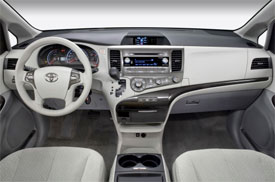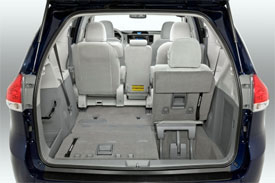2011 Toyota Sienna
When Toyota replaced the oddball Previa with the front-drive Sienna for 1998, it staked a firmer foothold in the minivan market. The redesigned 2004 Sienna added all-wheel-drive as an option, making it a true alternative to popular SUVs. Now, for 2011, the Sienna is all-new again, and it’s crossover utilities that dominate the family scene. So, let’s see if the new Sienna can stand its ground.
The 2011 Toyota Sienna minivan starts off by standing its ground on size. Its 119.3-inch wheelbase is the same as its predecessor. But it is a few fractions of an inch wider and shorter overall, much of which can be attributed to its all-new styling, penned entirely at Toyota’s Calty studio in Newport Beach, California. And, Calty has given Sienna a fairly aggressive version of the corporate notched hood, above a sharply tapered trapezoidal grille. Narrow, dramatically swept-back headlights are set high in a pair of bulging front fenders.
From there, the Sienna’s greenhouse follows the slight curvature of character lines drawn high on its flanks. Unmistakable Venza-like taillights wrap around under the D-pillars.
 Styling cues vary by trim. The sporty-looking SE’s mesh grille, deep splitter, rocker panels, and smoked taillights set it apart from the rest of the clean but much more pedestrian Sienna lineup. A selection of standard alloy wheels range from 17 to 19 inches in diameter.
Styling cues vary by trim. The sporty-looking SE’s mesh grille, deep splitter, rocker panels, and smoked taillights set it apart from the rest of the clean but much more pedestrian Sienna lineup. A selection of standard alloy wheels range from 17 to 19 inches in diameter.
But while a dose of exterior excitement is fine, the focal point of every minivan is the interior. To that end, the 2011 Sienna fills slightly bigger shoes than last year, with two inches added to interior length. It’s also wider inside, and the now flowing dash has a less pronounced, more integrated center stack to make it feel even roomier.
The front seat passengers are treated to a funky asymmetrical trim swoosh separating two glove boxes, and the driver will find a more upscale instrument cluster with standard ECO driving indicator in the multifunction liquid crystal screen. A full complement of airbags includes one for the driver’s knee.
Standards include tri-zone climate, CD stereo with aux input, up to a dozen cup holders, and dual sliding doors with power windows. Ascend the trim levels, and amenities like wood trim, voice command navigation, and a novel sliding center console are available.
Unlike Chrysler’s minivans, the Sienna’s second row seats don’t fold into the floor. They’re heavy, but are removable. Seven-passenger models have twin captain’s chairs. In Limited trim they recline. The eight-seater features a split bench with a stowable center section. The captain’s chairs have 23 inches of fore/aft travel and seat cushions that tip up, allowing easy access to the third row. There, the 60/40 split bench is placed two inches further back than before for adult-size legroom.
The optional rear entertainment system has a 16.4-inch screen that can display two inputs—like a movie and a game—at the same time. Unlike Chrysler vans, however, satellite TV is not available.
 Cargo volume behind the upright third seat is good at 39.1 cubic feet. Drop the third row and cargo volume goes to 87.1 cubic feet. With the second row removed, cargo volume grows to 150 cubic feet, or more than all rivals.
Cargo volume behind the upright third seat is good at 39.1 cubic feet. Drop the third row and cargo volume goes to 87.1 cubic feet. With the second row removed, cargo volume grows to 150 cubic feet, or more than all rivals.
Sienna continues as the only minivan available with all-wheel-drive. For 2011, it returns as an option on V6-powered LE, XLE, and Limited models.
Base power comes from the Sienna's first four cylinder. The 2.7-liter, shared with Highlander and Venza, rates 187 horsepower and 186 pound-feet of torque. The carryover 3.5-liter V6 rates 266 horsepower and 245 pound-feet of torque. A new six-speed transmission with sequential shift handles gear changes for both motors. With the V6, Sienna can tow 3,500 pounds.
Suspension hardware is traditional minivan, strut front and a beam axle rear. But careful retuning, stability control, and new electric power steering provide Sienna an unusually tactile driving experience, especially the SE, which gets treated to an even sportier setup. All-disc ABS brakes are standard.
While the four-cylinder does strain a little under heavy loads, its Government Fuel Economy ratings of 19 city/26 highway are the best in its class. The front drive V6 rates 18 city/24 highway, dropping to 16 city/22 highway with all-wheel-drive. All Siennas run on regular gas.
When it goes on sale later this spring, Sienna prices will start slightly lower than last year at $25,010. The V6 starts at $26,250, and can climb to an eye-popping $40,520 for an all-wheel drive Limited.
That said, the 2011 Toyota Sienna has something for every minivan taste— a more economical four-cylinder, class-exclusive all-wheel drive, and the nicely sporty SE model. So, not only can this highly versatile vehicle stand its ground, it's likely to make a few more suburbanites think twice about buying a big CUV.Specifications
- Engine: 2.7-Liter Four Cylinder
- Horsepower: 187
- Torque: 186 Lb Feet
- EPA: 19 MPG City/ 26 MPG Highway
2025 Volkswagen ID. Buzz
Volkswagen Brings Beetlemania Level Of Excitement To Minivan Segment
The duty of upholding Volkswagen’s heritage has most recently been delegated to small legacy car names like Golf and Jetta. But hold on! A much larger, totally modern take on VW’s classic microbus has just buzzed over the horizon— the all-electric ID. Buzz. It’s been at the top of our minds since we first saw the concept back in 2017. Well, it’s finally here, so let’s get our groove into drive!
This 2025 Volkswagen ID. Buzz has indeed created the most buzz around Volkswagen since the Beetle’s return to the U.S. in the late 1990s. We couldn’t drive it anywhere without drawing a crowd. No wonder, just about everyone has a VW Microbus story to tell, and seeing this reimagined version rolling down the street brings back all those memories.
VW really pulled it off as far as we’re concerned, as it looks great without appearing over the top. All the cues are here: Big VW logo front and center, lots of greenhouse including A-pillar windows and mini sliders for the second-row passengers, D-pillar air vents, and two-tone wheels. And while its appearance may be pure retro, its drivetrain is far from it, as the ID. Buzz is all-electric, and unlike the new Beetle, the Buzz does retain the original Microbus’ rear-drive architecture.
Powering those rear wheels is a 210-kW motor drawing juice from a 91-kWh battery for a range of 234 miles; 200-kW max charging will get you to 80% in about 26 minutes. Buyers can add another small 80-kW motor up front for 4motion all-wheel-drive and an increase of total output from 282 to 335 horsepower with a combined 512 lb-ft of torque. It uses the same battery, but range estimates drop just slightly to 231 miles. But while those numbers are modest, we also found them to be quite conservative, as we observed as many as 287 miles available in our all-wheel-drive tester’s gauge display and were on pace for 273 miles in our driving loop.
One throwback theme that may be a turnoff to some is that it’s quite a step up into the Buzz’s front seats, but there’s certainly a commanding view of the road once you climb in. Second row seating can be either a three-place bench or a pair of captain’s chairs, so there’s generous room for seven or six passengers. The captain’s chairs in our Pro S Plus offer good support and very easy access to the third row.
Lots of flexibility too with the option to simply fold the seats or remove them altogether.
With the sliding side doors and a wide opening rear hatch, there’s plenty of access for loading big sport utility amounts of cargo. Lots of flexibility too with the option to simply fold the seats or remove them altogether, and the ability to create a full-length flat floor with a rear cargo shelf that covers some handy removable storage bins. There’s 18.6 cubic-feet of space behind the third row, 75.5 behind the second, and a max of 145.5. That’s more than a Chevrolet Tahoe. For smaller items, there are lots of cubbies throughout the cabin, along with a standard Buzz Box that can be moved to multiple locations.
With a design that prioritizes retro form and modern function over aero efficiency, the 4motion equipped ID. Buzz earns a Fair efficiency rating, using 42-kWh of electricity per 100 miles, and we weren’t sure what to expect at our Mason Dixon test track.
What we found was great torque off the line and drama free launches to 60 in just 5.3 seconds. It was very stable at speed and power delivery stayed steady most of the way down the track until we reached about 90 mph, when it began to taper off just before we finished the quarter-mile in 14.0 seconds flat at 97 mph.
With 1,200-lbs. of battery weight nestled in its 127.5-inch wheelbase, the Buzz felt planted to the pavement through our handling course. There was quite a bit of body roll to deal with, but surprisingly little understeer. In panic braking runs, pedal response was inconsistent, feeling soft at times, pushing back hard at others; but through it all, results were quite good, stopping from 60 in an average of just 108 feet.
Three interior themes are available, this Dune is the brightest, featuring coastal inspired wood optic dash décor, “gray and clay” leatherette surfaces, and a high-mounted central 12.9-inch touchscreen. Pricing starts with a rear-wheel-drive Pro S at $61,545; this Pro S Plus begins at $65,045, add another $4,500 for 4motion, which brings a few extra features along with all-wheel drive.
Retro design with old-school VW charm, modern EV drivetrain, big SUV capacity merged with minivan flexibility; it all comes together in this 2025 Volkswagen ID. Buzz. It’s easily one of the coolest rides of the year and one that will likely keep Volkswagen dealers buzzing for years to come, and that’s something no other people and things mover can say.
Specifications
As Tested
- Motor Setup: Dual-Motor AWD
- Battery Size: 91-kWh
- Horsepower: 335
- Torque: 512 lb-ft
- EPA Range: 231 miles
- 0-60 mph: 5.3 seconds
- 1/4 Mile: 14.0 seconds at 97 mph
- Braking, 60-0: 108 feet
- MW Test Loop: ~ 273 miles













































